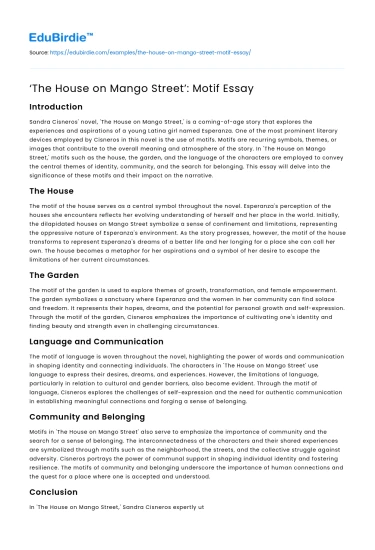Introduction
Sandra Cisneros' novel, 'The House on Mango Street,' is a coming-of-age story that explores the experiences and aspirations of a young Latina girl named Esperanza. One of the most prominent literary devices employed by Cisneros in this novel is the use of motifs. Motifs are recurring symbols, themes, or images that contribute to the overall meaning and atmosphere of the story. In 'The House on Mango Street,' motifs such as the house, the garden, and the language of the characters are employed to convey the central themes of identity, community, and the search for belonging. This essay will delve into the significance of these motifs and their impact on the narrative.
The House
The motif of the house serves as a central symbol throughout the novel. Esperanza's perception of the houses she encounters reflects her evolving understanding of herself and her place in the world. Initially, the dilapidated houses on Mango Street symbolize a sense of confinement and limitations, representing the oppressive nature of Esperanza's environment. As the story progresses, however, the motif of the house transforms to represent Esperanza's dreams of a better life and her longing for a place she can call her own. The house becomes a metaphor for her aspirations and a symbol of her desire to escape the limitations of her current circumstances.
Save your time!
We can take care of your essay
- Proper editing and formatting
- Free revision, title page, and bibliography
- Flexible prices and money-back guarantee
The Garden
The motif of the garden is used to explore themes of growth, transformation, and female empowerment. The garden symbolizes a sanctuary where Esperanza and the women in her community can find solace and freedom. It represents their hopes, dreams, and the potential for personal growth and self-expression. Through the motif of the garden, Cisneros emphasizes the importance of cultivating one's identity and finding beauty and strength even in challenging circumstances.
Language and Communication
The motif of language is woven throughout the novel, highlighting the power of words and communication in shaping identity and connecting individuals. The characters in 'The House on Mango Street' use language to express their desires, dreams, and experiences. However, the limitations of language, particularly in relation to cultural and gender barriers, also become evident. Through the motif of language, Cisneros explores the challenges of self-expression and the need for authentic communication in establishing meaningful connections and forging a sense of belonging.
Community and Belonging
Motifs in 'The House on Mango Street' also serve to emphasize the importance of community and the search for a sense of belonging. The interconnectedness of the characters and their shared experiences are symbolized through motifs such as the neighborhood, the streets, and the collective struggle against adversity. Cisneros portrays the power of communal support in shaping individual identity and fostering resilience. The motifs of community and belonging underscore the importance of human connections and the quest for a place where one is accepted and understood.
Conclusion
In 'The House on Mango Street,' Sandra Cisneros expertly utilizes motifs to deepen the reader's understanding of the central themes of identity, community, and the search for belonging. Through the recurring symbols of the house, the garden, language, and community, Cisneros creates a rich and multi-layered narrative that resonates with readers. The motifs serve as powerful tools to convey the challenges, dreams, and aspirations of Esperanza and the characters in her community. They invite readers to reflect on their own experiences of identity and the universal human need for connection and belonging.






 Stuck on your essay?
Stuck on your essay?

